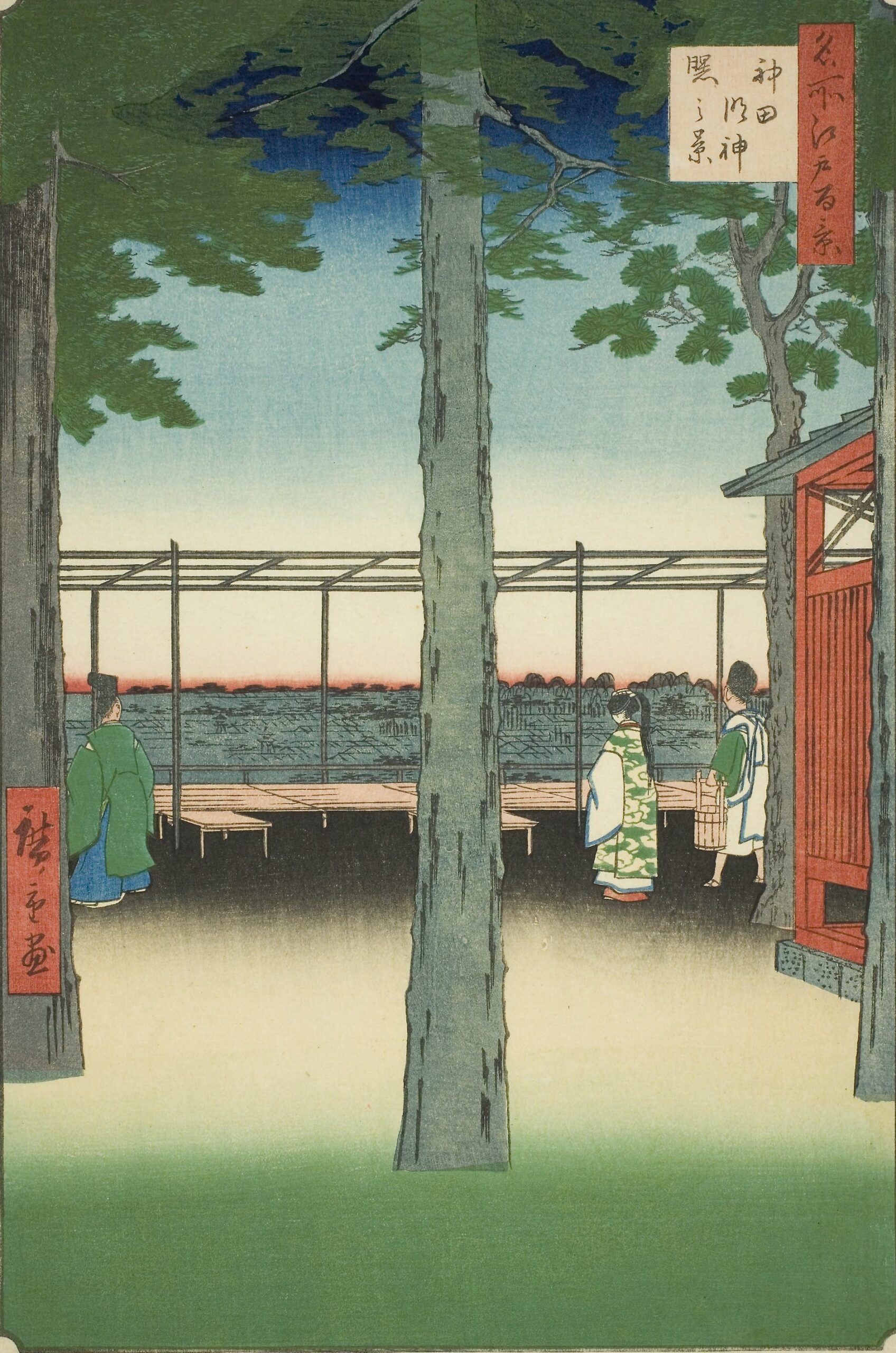
Utagawa Hiroshige – One Hundred Famous Views of Edo – 10 – Spring – Kanda Myojin Shrine at Dawn 歌川広重-名所江戸百景-10-春-神田明神曙之景
Current Address: Kanda Myojin, Sotokanda 2-chome, Chiyoda-ku
Latitude and Longitude: Latitude 35.7021, Longitude 139.7708
Published: September 1857 Age: 61
Comment
<1> Introduction
“Kanda Myojin Shrine at Dawn” is based on Kanda Myojin, one of the most beloved and revered shrines for the common people of Edo.
The painting depicts a majestic scene with the light of dawn shining through, conveying the richness of Edo’s religious faith and townspeople’s culture.
<2> About Kanda Myojin
Kanda Myojin’s official name is “Kanda Shrine.” It is said to have been founded in 730 and has been revered as the town’s guardian deity throughout Edo’s development.
After Tokugawa Ieyasu prayed for victory at the Battle of Sekigahara, Kanda Myojin gained the protection of the shogunate and established itself as the main guardian deity of Edo.
The enshrined deities are:
Ichinomiya: Onamuchi-no-Mikoto (also known as Daikoku-sama)
Ninomiya: Sukunahikona-no-Mikoto (also known as Ebisu-sama)
Sannomiya: Taira no Masakado-no-Mikoto
As Taira no Masakado is enshrined here, it is believed to bestow blessings of lasting military fortune and protection on the lives of ordinary people, and many people visit the shrine.
The Kanda Festival is one of Edo’s three major festivals.
The portable shrine (mikoshi) was permitted to enter Edo Castle, and it was a grand national festival attended by even the shogun.
Even in Hiroshige’s time, Kanda Myojin was a symbolic shrine of Edo.
<3> Highlights of the painting
As the name “akebono” (dawn) suggests, the painting depicts the morning sun beginning to rise in the eastern sky.
The sky changes from pale pink to gold, and the light illuminating the sacred grounds accentuates their sacredness.
The shrine building within the grounds is depicted in the center of the image, indicating its presence as a center of faith for the common people of Edo.
The vermilion-painted pillars and curved roofs combine dignity and splendor.
Smaller figures of townspeople arriving to worship early in the morning are depicted.
For the common people, Kanda Myojin was a god who protected their daily lives.
The sight of people making pilgrimages at dawn symbolizes the religious spirit of the time.
The town of Edo spreads out in the background, and the silhouette of Mount Fuji can be seen in the distance. This composition, capturing the harmony of shrine, city, and nature in one image, is typical of Hiroshige.
Kanda Myojin, beloved for its annual festivals held alternately on September 15th with Hiyoshi Sanno Gongen Shrine, is depicted from the back rather than the front.
The vermilion-painted shrine building on the far right suggests that this is within the temple grounds.
Kanda Myojin, which still stands on the grounds of Yushima, is open to the east, as can be seen in the illustration.
The three figures, from left to right, appear to be a priest, a shrine maiden, and a servant.
They are looking out to the view that stretches out to the east and the brightening sky.
Other than the fact that it is dawn, there is no other indication of the season.
As the servant is holding a bucket, the scene is thought to have taken place after the New Year’s water-drawing ceremony.
<4> Kanda Myojin for the Common People of Edo
With a wide range of blessings, including prosperity in business, recovery from illness, and matchmaking, it was a source of spiritual refuge for the common people.
For merchants in particular, Daikoku-sama and Ebisu-sama were powerful guardian deities.
On the other hand, Taira no Masakado was deeply worshipped by samurai and townspeople.
Worshipped as the local god of Edo, Masakado was revered as “an ally of the common people,” despite being a rebel.
The Kanda Festival was more than just a religious event; it was also one of Edo’s largest entertainment venues.
Townspeople carried portable shrines and floats and enjoyed a spectacular procession, reportedly filling the entire Edo period with excitement.
<5> Visiting Modern-Day Kanda Myojin
Conveniently located just a few minutes’ walk from Akihabara, Kanda Myojin Shrine’s side-by-side location is a symbol of old and new Tokyo.
Highlights include:
– The magnificent vermilion-lacquered main building (rebuilt during the Showa period)
– The temple grounds, bustling with worshippers praying for business prosperity
– The view of the Tokyo cityscape from the grounds
The Kanda Festival, still held every other year, boasts a tradition dating back hundreds of years.
Today, many IT companies and creators visit the shrine, and collaborative events with anime and manga are also popular.
<6> Tourist Guide
1. Morning Worship
If you want to recreate Hiroshige’s “Dawn,” we recommend visiting early in the morning.
Welcoming the sunrise amid the tranquil grounds is an exceptional experience.
② Historical Exploration
By touring the grounds’ Masakado Tomb and documents related to the Kanda Festival, you can understand the deep connection between the common people of Edo and Kanda Myojin.
③ Stroll around Akihabara as well
Only in Tokyo can you enjoy both an electronics district and a shrine at the same time.
④ Goshuin (temple stamps) and omamori (charms)
Auspicious items related to Daikoku and Ebisu are popular souvenirs.

内八ツ小路-120x68.jpg)
